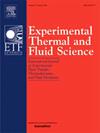船用发动机工况下不同孔径液氨喷雾的实验分析
IF 3.3
2区 工程技术
Q2 ENGINEERING, MECHANICAL
Experimental Thermal and Fluid Science
Pub Date : 2025-08-09
DOI:10.1016/j.expthermflusci.2025.111580
引用次数: 0
摘要
为了实现零碳排放目标,氨在大功率船用发动机中的应用越来越受到关注。由于氨具有独特的闪沸特性,孔口直径对其喷雾特性的影响有待进一步研究。在高压条件下(喷射压力达100 MPa,环境压力达6 MPa),采用三种喷嘴孔径(0.15 mm、0.3 mm和0.45 mm)对液氨喷雾宏观特性进行了综合实验分析。结果表明,环境压力比喷射压力对喷雾特性的影响更为显著。值得注意的是,闪速沸腾显著增强了径向喷雾膨胀,特别是在较大孔径的喷雾中造成了大量的轴向动量损失。在非闪蒸区,小孔直径的喷雾在初始阶段发展较快,但大孔直径的喷雾在后期的穿透距离、速度和面积上表现优异。在此基础上,提出了一种喷雾头侵彻预测模型,并验证了该模型在不同孔径下的适用性,为孔径优化提供了参考依据。通过等效比计算分析预测喷雾的燃油空气混合程度,结果表明,在闪速沸腾工况下,0.3 mm孔径最优,而在非闪速沸腾和高压船用发动机工况下,0.45 mm孔径更为有效。这些发现为氨燃料船舶推进系统的设计和优化提供了重要贡献,推动了可持续海事技术的发展。本文章由计算机程序翻译,如有差异,请以英文原文为准。
Experimental analysis of liquid ammonia spray with different orifice diameter under marine engine conditions
The application of ammonia in high-power marine engines has been receiving more attention on achieving zero-carbon emission goals. Due to the unique flashing boiling characteristics of ammonia, the influence of orifice diameter on its spray characteristics needs further research. Present study presents a comprehensive experimental analysis of liquid ammonia spray macroscopic characteristics using three injector orifice diameters (0.15 mm, 0.3 mm, and 0.45 mm) under high-pressure conditions (injection pressure up to 100 MPa, ambient pressure up to 6 MPa). The results show that ambient pressure exerts a more pronounced influence on spray characteristics than injection pressure. Notably, flash boiling significantly enhances radial spray expansion, particularly causing substantial axial momentum loss in sprays from larger orifice diameter. In non-flash boiling region, although the spray from small orifice diameter develops rapidly at the initial stage, the spray from large orifice diameter exhibits superior performance in penetration distance, velocity and area during later stages. Based on these experimental results, a developed prediction model on spray tip penetration is proposed and verified to be well applicable to different orifice diameters, which provides a reference for orifice diameter optimization. According to the predicted fuel–air mixing degree of spray analyzed through equivalent ratio calculation, present results indicate 0.3 mm orifice diameter is optimal for flash boiling conditions, whereas a 0.45 mm diameter proves more effective for non-flash boiling and high-pressure marine engine operations. These findings offer significant contributions to the design and optimization of ammonia-fueled marine propulsion systems, advancing the development of sustainable maritime technologies.
求助全文
通过发布文献求助,成功后即可免费获取论文全文。
去求助
来源期刊

Experimental Thermal and Fluid Science
工程技术-工程:机械
CiteScore
6.70
自引率
3.10%
发文量
159
审稿时长
34 days
期刊介绍:
Experimental Thermal and Fluid Science provides a forum for research emphasizing experimental work that enhances fundamental understanding of heat transfer, thermodynamics, and fluid mechanics. In addition to the principal areas of research, the journal covers research results in related fields, including combined heat and mass transfer, flows with phase transition, micro- and nano-scale systems, multiphase flow, combustion, radiative transfer, porous media, cryogenics, turbulence, and novel experimental techniques.
 求助内容:
求助内容: 应助结果提醒方式:
应助结果提醒方式:


